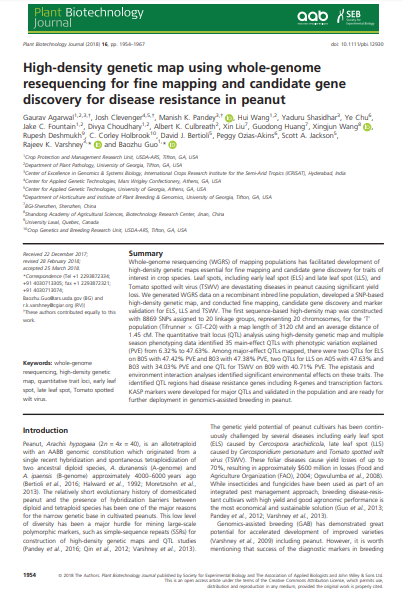High-density genetic map using whole-genome resequencing for fine mapping and candidate gene discovery for disease resistance in peanut
Summary
Whole-genome resequencing (WGRS) of mapping populations has facilitated the development of high-density genetic maps that are essential for fine mapping and candidate gene discovery for traits of interest in crop species. Leaf spots, including early leaf spot (ELS) and late leaf spot (LLS), and tomato spotted wilt virus (TSWV) are devastating diseases in peanut causing significant yield losses. We generated WGRS data on a recombinant inbred line population, developed an SNP-based high-density genetic map, and conducted fine mapping, candidate gene discovery, and marker validation for ELS, LLS, and TSWV. The first sequence-based high-density map was constructed with 8869 SNPs assigned to 20 linkage groups, representing 20 chromosomes, for the ‘T’ population (Tifrunner × GT ‐C20) with a map length of 3120 cM and an average distance of 1.45 cM. Quantitative trait locus (QTL) analysis using high-density genetic map and multiple season phenotyping data identified 35 main-effect QTL s with phenotypic variation explained (PVE) from 6.32% to 47.63%. Among the major-effect QTLs mapped, there were two QTLs for ELS on B05 with 47.42% PVE and B03 with 47.38% PVE, two QTLs for LLS on A05 with 47.63% and B03 with 34.03% PVE, and one QTL for TSWV on B09 with 40.71% PVE. The epistasis and environment interaction analyses identified significant environmental effects on these traits. The identified QTL regions had disease resistance genes, including R-genes and transcription factors. KASP markers were developed for major QTL-s and validated in the population and are ready for further deployment in genomics-assisted breeding in peanut.
Open resource Download resource Access resource on external site

